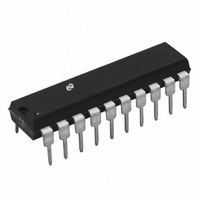LM2202N National Semiconductor, LM2202N Datasheet - Page 5

LM2202N
Manufacturer Part Number
LM2202N
Description
IC VIDEO AMP SYSTEM 20-DIP
Manufacturer
National Semiconductor
Datasheet
1.LM2202M.pdf
(17 pages)
Specifications of LM2202N
Applications
General Purpose
Number Of Circuits
1
-3db Bandwidth
230MHz
Current - Supply
48mA
Current - Output / Channel
28mA
Voltage - Supply, Single/dual (±)
8 V ~ 13.2 V
Mounting Type
Through Hole
Package / Case
20-DIP (0.300", 7.62mm)
Lead Free Status / RoHS Status
Contains lead / RoHS non-compliant
Other names
*LM2202N
Available stocks
Company
Part Number
Manufacturer
Quantity
Price
Part Number:
LM2202N
Manufacturer:
NS/国半
Quantity:
20 000
Circuit Description
provides a 6 dB gain adjustment range. This feature is nec-
essary for RGB applications where independent gain adjust-
ment of each channel is required.
The brightness or black level clamping requires a “sample
and hold” circuit which holds the DC bias of the video ampli-
fier constant during the black level reference portion of the
video waveform. Black level clamping, often referred to as
DC restoration, is accomplished by applying a back porch
clamp signal to the clamp gate input pin (pin 14). The clamp
comparator is enabled when the clamp signal goes low dur-
ing the black level reference period (see Figure 2 ). When the
clamp comparator is enabled, the clamp capacitor con-
nected to pin 12 is either charged or discharged until the volt-
age at the minus input of the comparator matches the volt-
age set at the plus input of the comparator. During the video
portion of the signal, the clamp comparator is disabled and
the clamp capacitor holds the proper DC bias. In a DC
coupled cathode drive application, picture brightness func-
tion can be achieved by varying the voltage at the compara-
tor’s plus input. Note that the back porch clamp pulse width
(t
eration.
VIDEO AMPLIFIER SECTION (Input Stage)
A simplified schematic of LM2202’s video amplifier input
stage is shown in Figure 3 . The 5.4V zener diode, Q1, Q6
and R2 bias the base of Q7 at 2.6V. The AC coupled video
W
in Figure 2 ) must be greater than 100 ns for proper op-
(Continued)
FIGURE 2. Block Diagram of the LM2202 Video Amplifier
with Contrast and Brightness (Black Level) Control
5
signal applied to pin 6 is referenced to the 2.6V bias voltage.
Transistor Q7 buffers the video signal, V
the voltage to current. The AC collector current through Q8 is
I
and Q11 are off and all of I
R10 and R11. The maximum signal gain at the base of Q13
is, A
achieved by varying the base drive to the differential pairs
Q9, Q10 and Q11, Q12 thereby unbalancing the collector
currents through the transistor pairs. Base of Q10 is biased
at 5.3V by externally connecting pin 1 to pin 20 through a
100 resistor. Pin 2 is connected to pin 3 through a 100 re-
sistor. Adjusting the contrast voltage at pin 8 produces a con-
trol voltage at pin 3 which drives the base of Q9. By varying
the voltage at the base of Q9, Q8’s collector current (I
diverted away from the load resistors R10 and R11, thereby
providing signal attenuation. Maximum attenuation is
achieved when all of I
flows through the load resistors.
The differential pair Q11 and Q12 provide drive control.
Q12’s base is internally biased at 7.3V. Adjusting the voltage
at the drive control input (pin 9) produces a control voltage at
the base of Q11. With Q9 off and Q12 off, all of I
through R10, thus providing a gain of A
= −1. Drive control thus provides a 6 dB attenuation range.
C8
= V
V1
IN
= −(R10 + R11)/R9 = −2. Signal attenuation is
/R9. Under maximum gain condition, transistors Q9
C8
C8
flows through Q9 and no current
flows through the load resistors
V1
IN
= −(R10/R9) x V
, and Q8 converts
www.national.com
DS012591-8
C8
C8
flows
) is
IN











